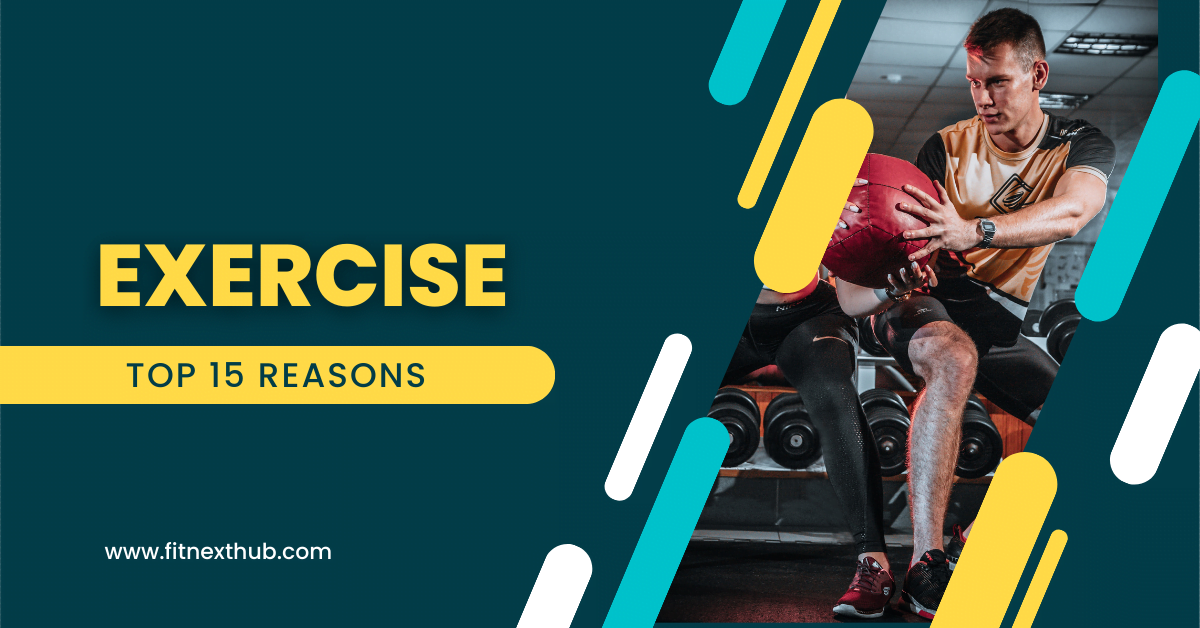Why I Exercise: The Top 15 Reasons Why I Move My Body Every Day

Exercise is one of the best things you can do for your overall health and well-being. It improves heart health, lowers disease risk, strengthens muscles and bones, boosts energy, and aids in weight control. Exercise has mental and emotional benefits like reducing stress, improving mood, increasing focus, and leading to better sleep.
The physical benefits of exercise
Improved cardiovascular health: It strengthens the heart and improves circulation. This can help to reduce the risk of heart disease, stroke, and other cardiovascular problems.
Reduced risk of chronic diseases: It has been shown to reduce the risk of developing a number of chronic diseases, including type 2 diabetes, obesity, some types of cancer, and osteoporosis.
Stronger muscles and bones: It helps to build and strengthen muscles and bones. This can help to improve balance coordination and reduce the risk of falls and injuries.
Increased energy levels: It helps to improve cardiovascular fitness and increase stamina. This can lead to increased energy levels throughout the day.
Weight management: It can help to burn calories and promote weight loss. It can also help to maintain a healthy weight in the long term.
The mental and emotional benefits of exercise
Reduced stress and anxiety: It releases endorphins, which have mood-boosting effects. It can also help to take your mind off of your worries and provide a sense of accomplishment.
Improved mood and self-esteem: It can help to improve mood and self-esteem by releasing endorphins and promoting a sense of well-being. It can also help to improve body image and self-confidence.
Increased focus and productivity: It can help to improve focus and concentration by increasing blood flow to the brain. It can also help to reduce fatigue and improve alertness.
Better sleep: It can help to improve sleep quality by reducing stress and promoting relaxation. It can also help to regulate the circadian rhythm, which is the body’s natural sleep-wake cycle.
Stronger social connections: It can be a great way to meet new people and make friends. There are many social activities that involve exercise, such as group fitness classes, team sports, and hiking clubs. It can also help to improve your mood and self-confidence, which can make you more outgoing and social.
How to find the right exercise routine for you
When choosing an It routine, it is important to consider your fitness goals, interests, and schedule. It is also important to start slowly and gradually increase the intensity and duration of your workouts to avoid injuries.
Here are some tips for finding the right exercise routine for you:
Consider your fitness goals. What do you hope to achieve with your exercise routine? Do you want to lose weight, gain muscle, or improve your cardiovascular health? Once you know your goals, you can choose activities that will help you reach them.
Find activities you enjoy. If you don’t enjoy your exercise routine, you are less likely to stick with it. Choose activities that you find fun and challenging.
Start slowly and gradually increase the intensity and duration of your workouts. This will help to prevent injuries and burnout.
Listen to your body and take breaks when needed. Don’t push yourself too hard, especially when you are first starting. If you feel pain, stop the activity and rest.
Tips for staying motivated
It can be not easy to stay motivated to do It regularly, especially if you are new to it. Here are some tips for staying motivated:
Set realistic goals. Don’t try to do too much too soon. Set small goals for yourself and gradually increase them as you get stronger.
Find a workout buddy. Having someone to It with can help you stay motivated and accountable.
Vary your routine. If you do the same exercises every day, you are more likely to get bored and give up. Try different activities and workouts to keep your routine interesting.
Reward yourself for your progress. When you reach a fitness goal, reward yourself with something you enjoy. This will help you stay motivated to keep going.
Overcoming common exercise challenges
There are a number of common challenges that people face when trying to do It regularly. Here are some tips for overcoming these challenges:
Lack of time: If you are short on time, there are still ways to fit It into your day. Try breaking up your workouts into shorter sessions throughout the day. You can also find It that can be done at home or during your lunch break.
Lack of motivation: If you are struggling to find motivation, try setting small goals for yourself and finding activities that you enjoy. You may also want to find a workout buddy or join a fitness class to help you stay on track.
Injuries: If you are injured, it is important to rest and let your body heal. Once you are cleared to exercise again, start slowly and gradually increase the intensity and duration of your workouts.
Health conditions: If you have a health condition, talk to your doctor before starting a new exercise routine. They can help you create a plan that is safe and effective for you.
How to make exercise a part of your lifestyle
The best way to make It a part of your lifestyle is to find ways to incorporate it into your daily routine. Here are some tips:
Schedule time for exercise in your day. Just like you would schedule any other important appointment, schedule time for exercise in your day; this will help you make exercise a priority and avoid skipping workouts.
Keep your workout gear handy. Keep your workout clothes and shoes in a convenient place so that you can easily change into them and start exercising.
Find ways to incorporate exercise into your daily activities. Instead of taking the elevator, take the stairs. Instead of driving to the store, walk or bike. You can also find ways to incorporate exercise into your work routine, such as taking breaks to stand and move around or taking a walk during your lunch break.
Make exercise a social event. Exercise with friends or family members. This can make exercise more fun and motivating.
My personal journey with exercise
I used to avoid exercise at all costs. I hated sweating, and I didn’t think I was good at sports. But one day, I decided that I wanted to make a change. I wanted to be healthier and more active. So, I started slowly. I started by going for walks a few times a week. Then, I started running. And then, I started taking fitness classes.
At first, it was tough. But the more I exercised, the better I felt. I had more energy, I slept better, and I was happier.
I also started to lose weight and feel more confident in my body. It became a part of my daily routine and something that I looked forward to.
I still have days when I don’t feel like exercising. But on those days, I remind myself of all the benefits of exercise and how good it makes me feel. I also try to find activities that I enjoy, such as going for a walk in the park or taking a dance class.
Conclusion
It is one of the best things you can do for your overall health and well-being. It has a number of physical and mental benefits, and it can help you to live a longer and healthier life.
If you are new to exercise, start slowly and gradually increase the intensity and duration of your workouts. It is also important to find activities that you enjoy and to make exercise a part of your daily routine.
FAQs
What is the best type of exercise for me?
The best type of exercise for you is the type that you enjoy and that you can stick with. There are many different types of exercise to choose from, such as walking, running, swimming, biking, dancing, and strength training.
If you are still determining what type of It is right for you, talk to your doctor. They can help you create a plan that is safe and effective for you.
How often should I exercise?
The Centers for Disease Control and Prevention (CDC) recommends that adults get at least 150 minutes of moderate-intensity aerobic activity or 75 minutes of vigorous-intensity aerobic activity each week. Children and adolescents should get at least 60 minutes of physical activity each day.
You can break up your exercise into shorter sessions throughout the day. For example, you could do three 10-minute walks throughout the day or one 30-minute workout.
What if I don’t have time to exercise?
Even if you are short on time, there are still ways to fit exercise into your day. Try breaking up your workouts into shorter sessions throughout the day. You can also find exercises that can be done at home or during your lunch break.
Here are some examples of quick workouts that you can do:
- Take a brisk walk around the block.
- Do a few sets of push-ups, sit-ups, and squats.
- Go for a bike ride or run.
- Do a yoga or Pilates workout.
- Dance around your living room.
What if I need to be more motivated to exercise?
Here are some tips for staying motivated to exercise:
- Set realistic goals. Don’t try to do too much too soon.
- Find activities that you enjoy.
- Find a workout buddy.
- Vary your routine.
- Reward yourself for your progress.
What if I get injured while exercising?
If you get injured while exercising, it is important to rest and let your body heal. Once you are cleared to exercise again, start slowly and gradually increase the intensity and duration of your workouts.
If you have any pain, stop the activity and rest. If the pain is severe or does not improve after a few days, see a doctor.













